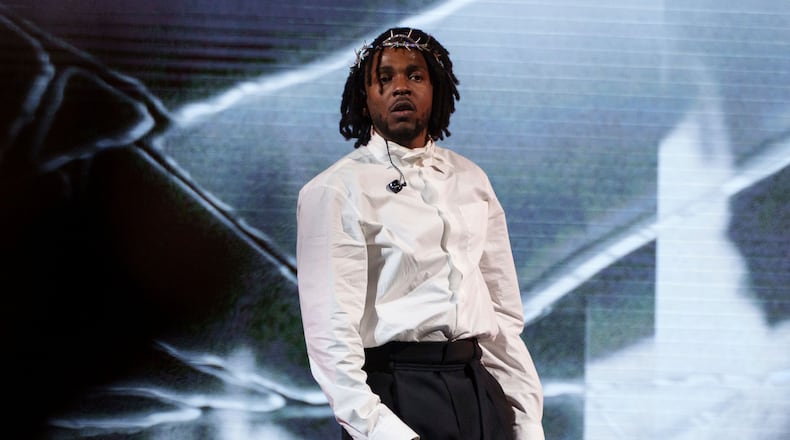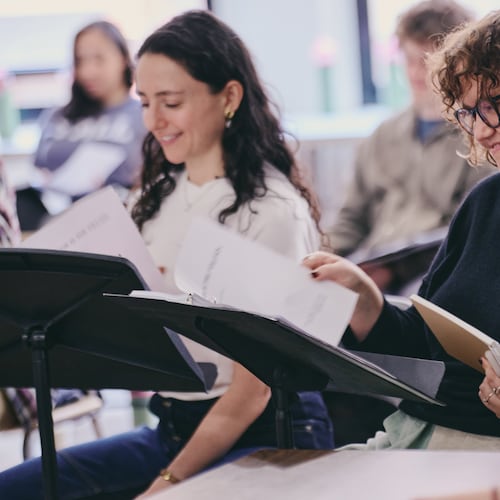It’s been five years since Kendrick Lamar released his groundbreaking Pulitzer Prize-winning album, “DAMN,” and in that time, he has continued on a quest to confront his past, get comfortable with his megastardom, and most recently, survive a devastating global health crisis with no certainty on what the future holds.
But not to worry. The Compton, California-born lyricist brought his Big Steppers Tour in support of his latest double album, “Mr. Morale and the Big Steppers,” to State Farm Arena on Saturday, July 30. The full performance is composed largely of songs from his current release with a playlist of tracks from all of his previous albums sprinkled throughout the show.
Credit: GREG NOIRE
Credit: GREG NOIRE
The 110-minute show is Lamar artistically interpreting that he’s more than prepared to do the necessary work through the haze of personal and social conflicts by using his music and stage as both weapons and healing tools. With its use of minimal props — such as heavy fog coming out of the vented stage — and its spasmodic, paparazzi-flavored lighting design, the Big Steppers Tour leans more towards modern hip-hopera than a standard rap concert.
Lamar didn’t wear his diamond-encrusted crown of thorns as seen on his latest album cover or during his Glastonbury performance from this past June. Instead, the 14-time Grammy winner emerges out of his comfort zone as Mr. Morale, his latest alter ego that’s typically situated by the piano and dressed like a military general in all black attire with brooches and medallions across his chest.
Wearing his dreadlocks in a ponytail and slightly dangling diamond earrings, Lamar dons gem-studded oval-shaped sunglasses while gripping his microphone with a singular rhinestone glove in what could very much act as a homage to Michael Jackson. Lamar, also known by the aliases King Kunta, Kung Fu Kenny or K.Dot, dresses the male steppers in black suits while the women compliment them in all-white suits.
The 35-year-old entertainer, born Kendrick Lamar Duckworth, opens the show with “United in Grief,” showing up at the piano with a doppelganger puppet that mimics his staccato, chopper-style delivery bar-for-bar. Mr. Morale then cuts and serves a slice of humble pie with “N95″ backed by strobe spotlighting, blazing fire torches and colorful pyrotechnics before leaping into “ELEMENT,” “Worldwide Steppers,” “Backseat Freestyle” and “Rich Spirit.”
Consistently delivering exceptional bars and keeping his wind up better than the average rapper the entire show, Lamar reimagines therapy sessions that journey into Mr. Morale’s isolation and process towards acceptance. Lots of echoing footsteps pacing, rhythmic heartbeats, footage of thunderstorms, West Coast b-roll, grainy performance footage, smoke and fog coming out the vented stage, and melodramatic silhouettes projected against white curtains help to steer it.
Following “HUMBLE,” Lamar, whose hopscotch-like footsteps turned golden yellow, sits alone in a chair backed by video animation of embryos for “Father Time,” brings out a bed that appears and lowers between “Die Hard” and “DNA,” gets flanked by the suited dancers with flashlights for “m.A.A.d. City,” and endures a lovers’ quarrel on “We Cry Together.”
Adjacent to the main stage is where K.Dot dramatizes the stress of overcoming quarantine because of the coronavirus. He takes a COVID-19 test on-stage at the request of a Siri-toned voiceover while churning out “Count Me Out,” “Money Trees,” and “LOVE.”
When his quadrilateral quarantine bubble appears, K. Dot breezes through the anthemic “Alright” with four bodies dressed in white hazmat suits standing in each corner of the cube. The Academy Award-nominated rapper returns to solitude in his space with “Mirror,” “LOYALTY,” and “Silent Hill.” The Big Steppers Tour’s opening act, Baby Keem, joins Lamar for “Family Ties” on the runway.
Lamar heads back to the piano for “Crown” with square lighting fixtures moving around over him. He goes into “Mr. Morale” before he abruptly closes out the show with “Savior” and no encore.
Even with its terse conclusion or minus one of his signature singles as a closing number, Lamar successfully executed a memorable show that didn’t require an overwhelming amount of high-end production and staging.
As one of the voiceovers indicates late in the show, “with great power comes great responsibility.” The Big Steppers Tour is proof that Lamar is easily one of this generation’s forerunning talents because he’s not afraid to center his own personal journey on the stage as entertainment.
About the Author
Keep Reading
The Latest
Featured


